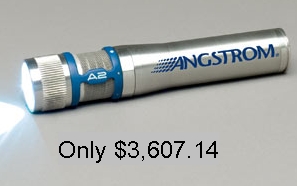

B.C. funds costly flashlights
IRRESISTIBLE SNIDE COMMENT: Would it kill these guys to make some gestures of support for wind instead of for these high-tech, high-waste gadgets? And what happens with the water produced in these flashlights? Does each user get something like a colostomy bag to carry around with the light? Squish, squish. This is what passes for energy policy in this province? Hmm, guys who can be sold gimmicks like this could probably be persuaded to buy a bridge or two. Hey, everyone, say Golden Ears! Say Bridges over Saanich Inlet!

By Russ Francis
Georgia Straight
Publish Date: 20-Jul-2006
In 2001, the B.C. Liberals campaigned on a platform that included a promise to “stamp out government waste”.
But a recent announcement by Energy, Mines and Petroleum Resources Minister Richard Neufeld suggests that the Liberals have yet to fully act on that promise.
At a press conference on July 14, Neufeld announced that the government has spent $25,250 on seven hydrogen-powered flashlights, a unit to refill the flashlights with hydrogen, and a fuel-cell battery charger.
That works out to $3,607.14 each.
The “A2” flashlights, made by Vancouver-based Angstrom Power Inc., will be used by security guards at Victoria’s Royal BC Museum. Angstrom chief executive officer Paul Zimmerman told reporters that he was reluctant to comment on the price of the flashlights or the recharging unit since they are prototypes. However, he said the flashlights would eventually drop to the $300-to-$400 range.
The flashlights use one-watt LEDs, producing about the same amount of light as ordinary battery-powered flashlights available at the hardware store for a lot less.
Admittedly, the A2 flashlights have several advantages over the battery-powered kind. For one thing, they run for 24 hours on a charge, compared with about four hours for the hardware-store variety, Zimmerman said. As well, they recharge in about 15 minutes, instead of an hour for the ordinary type.
In a later interview, Neufeld told the Georgia Straight that he wasn’t going to buy a hydrogen-powered flashlight for himself. But police and fire departments could buy them, he said.
Neufeld and Pauline Rafferty, CEO of the Royal BC Museum, told reporters that the flashlights were a way of looking to the future, which some see as being powered by hydrogen.
Superficially, hydrogen is an attractive fuel. When it burns, the only byproduct is water. It’s also abundant: the oceans are full of it. In fact, there’s more of it in the universe than any other element.
But hydrogen in water is not usable as fuel until it’s split off by one of several processes, all of which take energy. At the July 14 flashlight announcement, Angstrom’s Zimmerman called the technology “clean for the environment”.
Rafferty added that the hydrogen flashlights have “no negative impact on the environment”. However, according to at least one expert, using hydrogen as fuel is anything but environmentally benign.
The exact amount of energy needed to extract free hydrogen from water depends on the method used. But all use more energy than is gained from the hydrogen. As a January 2003 report by the International Energy Agency observes, “Hydrogen is an energy carrier, not an energy source.”
The most efficient way of using hydrogen is via a fuel cell, a device that produces electricity with water as the only emission. According to Donald Anthrop, professor emeritus of environmental studies at San Jose State University, using hydrogen fuel cells to power cars is bad for the environment.
In a December 7, 2004, briefing paper for the libertarian Cato Institute, “Hydrogen’s Empty Environmental Promise”, Anthrop demonstrated that using electricity produced in coal-fired power plants was a terribly inefficient way to separate hydrogen from water.
“One must put 140.8 kilowatt-hours of energy into the front end of a power plant to produce 17.4 kilowatt-hours of electricity from a hydrogen- powered fuel cell in an automobile,” Anthrop wrote. Switching all gasoline-powered vehicles in the U.S. to power based on hydrogen fuel cells would almost double net carbon emissions, Anthrop reported in the paper.
How about using wind power instead to produce the hydrogen? The International Energy Agency quickly put this dream to rest in its 2003 report. If all the transportation fuel used in France were replaced with hydrogen, it would require covering six percent of French territory with about 350,000 wind turbines.
There are alternatives, such as nuclear power. That would mean building 60 new 1,500-megawatt nuclear power plants, according to the report.
Neufeld told reporters that B.C. is supporting the “hydrogen highway”, a system of filling stations in Victoria, Vancouver, and Whistler designed to refuel hydrogen-powered cars.
But if anyone in Victoria believes that before long we’ll all be zooming around in hydrogen-powered cars, they might want to read the 2004 book The Hype About Hydrogen: Fact and Fiction in the Race to Save the Climate (Island Press, 2004), by U.S. energy researcher Joseph Romm.
“Neither government policy nor business investment should be based on the belief that hydrogen cars will have meaningful commercial success in the near- or medium-term,” Romm wrote in the book.
Last April, Neufeld told the house that his ministry had given $2 million in 2005 to Fuel Cells Canada (since renamed Hydrogen & Fuel Cells Canada), and that one staff member in his ministry works full-time on hydrogen. In addition, BC Hydro has spent about $6.5 million over the last few years on developing hydrogen, he said.
From what I can tell, all of that money is wasted.
Posted by Arthur Caldicott on 26 Jul 2006